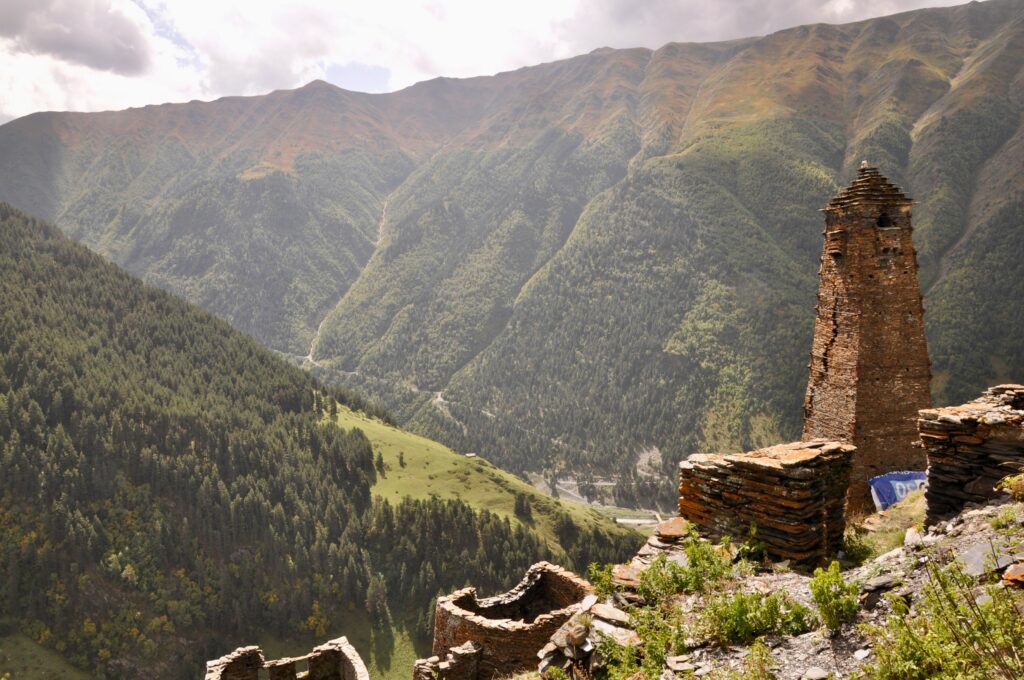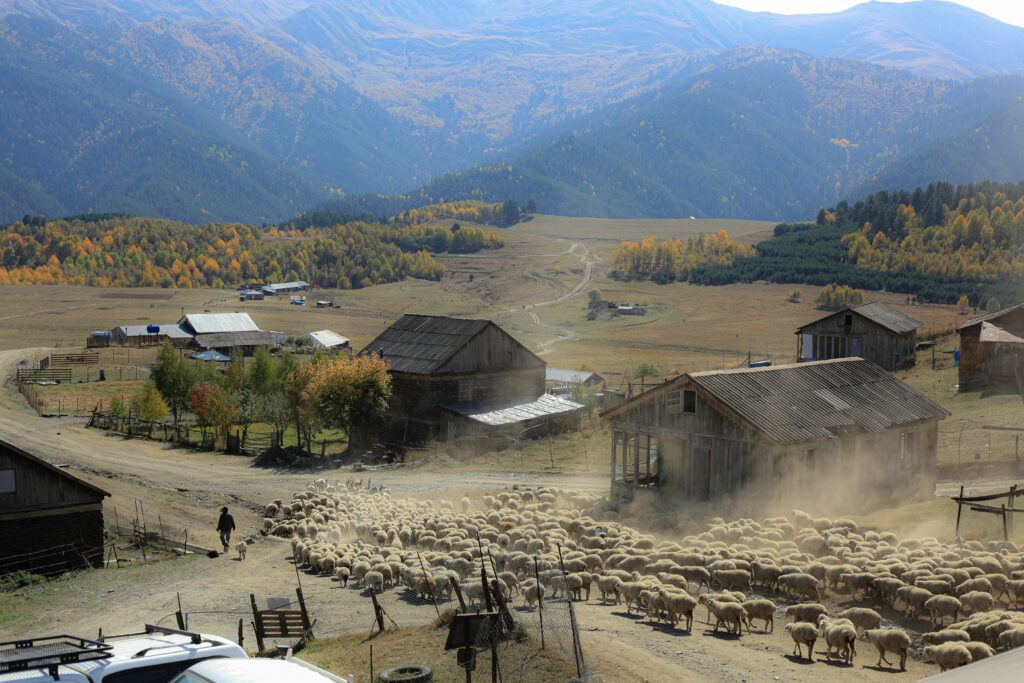Introduction
Nestled in the rugged Caucasus Mountains, Tusheti (Georgia) is one of Europe’s last untouched wildernesses. With its medieval stone towers, wildflower-strewn valleys, and nomadic shepherds, this remote region feels like stepping into a forgotten world. Unlike Georgia’s more touristy spots, Tusheti remains pristine—accessible only by a harrowing 4×4 journey over the Abano Pass (2,850m), a serpentine dirt track that clings to cliffsides and rewards the brave with jaw-dropping vistas.
I first visited Tusheti in 2021, lured by tales of its ancient fortified villages and legendary hospitality. Waking up to the scent of woodsmoke mingling with wild thyme, the sound of cowbells echoing across the hills, and the sight of shepherds guiding flocks through morning mist, I quickly understood why locals call this place “Georgia’s Shangri-La.”

Why visit Tusheti?
✔ Untamed landscapes – Alpine meadows blanketed in poppies, deep gorges carved by the Alazani River, and snow-capped peaks like Diklo Mountain (3,285m)
✔ Unique culture – Tush shepherds who spend summers in katos (mountain huts), UNESCO-listed villages with pagan shrines, and spine-tingling polyphonic singing
✔ Adventure-ready – Horseback riding along ancient trails, multi-day hikes to hidden valleys, and off-road expeditions to abandoned settlements
Pro Tip: Tusheti is only accessible June–September due to snow. Book 4×4 transport months ahead—locals joke the Abano Pass is “half road, half prayer.”
When to Visit Tusheti for the Best Experience
Best Time of Year
- June: Roads open, wildflowers bloom, and villages awaken after winter. Few tourists, but nights are cold (near freezing).
- July–August: Peak season with warm days (15–25°C). Perfect for hiking, though afternoon storms roll in like clockwork.
- September: Golden larch trees, crisp air, and fewer crowds. Ideal for photographers—but pack a heavy sleeping bag!
Avoid October–May: Heavy snow isolates villages. In 2020, a late September storm stranded travelers for days until helicopters evacuated them.
Weather Considerations
- Layered clothing is essential: Mornings start at 5°C, afternoons hit 25°C, and nights dip back to single digits.
- Rain gear: Storms can appear suddenly. My waterproof jacket saved me during a hailstorm near Kvavlo—pea-sized ice pellets ricocheted off the slate roofs like gunfire.
- Sun protection: At high altitudes, UV rays are fierce. A German hiker I met sported a blistering sunburn after forgetting his hat.
Personal Anecdote: One evening in Dartlo, a shepherd named Gela invited me to his kato. As we shared chacha (Georgian brandy) by the fire, he recounted how his ancestors defended these towers against Dagestani raids. The flames cast shadows on 500-year-old soot stains—history felt alive.
Off the Beaten Path Locations in Tusheti
1. Dartlo Village
A UNESCO-listed gem where slate-roofed towers cluster like stone sentinels. Don’t miss:
– Alaverdi Church (9th century): Faded frescoes of saints peer from cracked walls. Light a beeswax candle (sold by local women for 2 GEL).
– The “Stone Calendar”: A mysterious rock with carvings some believe track solstices.
– Evening magic: As dusk falls, the village glows amber under solar-powered lights (installed in 2022).
2. Omalo Fortress (Keselo Towers)
Perched above Lower Omalo, these 13th-century watchtowers were rebuilt in 2003 after Soviet neglect. Pro tips:
– Sunrise hike: The 45-minute climb rewards you with mist weaving through the Alazani Valley.
– Secret tunnel: Ask guides about the hidden escape route used during invasions.
3. Shenako & Diklo
- Shenako: Famous for wooden balconies draped in rugs. Visit St. George’s Church, where locals tie ribbons to a sacred oak.
- Diklo: A cliffside village with a medieval fortress teetering above the border. The 2-hour hike from Dartlo is vertigo-inducing but unforgettable.
Hidden Gem: Girevi, a near-abandoned hamlet where crumbling towers stand guard over valleys of wild garlic. In 2023, only three elderly residents remain.

Local Experiences You Can’t Miss
1. Shepherding with the Tush People
Spend a day with nomadic shepherds like Nukri, who’s herded sheep here for 40 years:
– Cheese-making: Help craft guda cheese in a kato—smoked over hay for a tangy, earthy flavor.
– Yurt visit: Some families still use felt yurts in summer. Sip sour matsoni yogurt while learning to spin wool.
2. Tushetian Horseback Riding
Local Tush horses—stocky, surefooted, and stubborn—are bred for these trails. Best routes:
– Omalo to Parsma (3 hours): Follow the Alazani River past grazing yaks.
– Night rides: Full-moon excursions (offered by Guesthouse Lile) feel straight out of a Tolkien novel.
3. Traditional Supra Feast
A 10-course marathon of hospitality:
1. Khinkali (dumplings) stuffed with wild mint and lamb
2. Chakapuli (stewed lamb with tarragon and white wine)
3. Badrijani (walnut-stuffed eggplant rolls)
Toasting etiquette: Never sip until the tamada (toastmaster) finishes speaking!
Must-Try Dish: Khavitsi—a hearty porridge of barley, cheese, and butter, eaten with hands from a communal pot.
Unique Accommodations in Tusheti
| Option | Best For | Price (USD) | Details |
|---|---|---|---|
| Guesthouses | Budget travelers | $15–$30/night | Shared bathrooms, home-cooked meals (try Guesthouse Ninoskhevi in Dartlo) |
| Shepherd Huts | Adventure seekers | Free (with local invite) | No electricity, but stars like you’ve never seen |
| Eco Lodges | Comfort lovers | $50–$100/night | Solar-powered Shina Tusheti has hot showers! |
My Pick: Guesthouse in Dartlo—fall asleep to the Tushetis Alazani River’s lullaby and wake to homemade korkoti (barley porridge).
Authentic Food Spots
- Omalo Guesthouse – Khavitsi served in a copper pot, with views of Keselo Towers.
- Café Lile (Dartlo) – Lobiani baked in a wood-fired oven—crispy crust, molten bean center.
- Homemade Wine Cellars – Sample amber wines from qvevri (clay vessels buried underground). Try: Kisi grape variety, aged with grape skins for tannic depth.
Tasting Tip: Churchkhela (walnut candy) is hiking fuel—buy from roadside stalls (5 GEL).
3-Day Tusheti Itinerary
Day 1: Omalo & Keselo Towers

- Morning: White-knuckle drive over Abano Pass. Stop at Kvavlo ruins—explore the roofless towers where wind whistles through arrow slits.
- Afternoon: Explore Omalo’s towers with guide Nika (find him at the visitor center). Watch artisans weave Tushetian wool hats.
- Evening: Sunset picnic at Keselo Fortress—pack sulguni cheese and shotis puri bread.
Day 2: Dartlo & Hiking
- Morning: Trek to Dartlo (2–3 hours). Detour to Chelchuray Waterfall—refill your bottle with icy meltwater.
- Afternoon: Visit Diklo’s cliffside ruins. Local legend says a secret tunnel leads to Dagestan!
- Evening: Supra feast at Guesthouse Makratela. Try kharcho (walnut soup) while the host sings mravalzhamier (polyphonic toast).
Day 3: Shenako & Girevi
- Morning: Horseback ride to Shenako (2 hours). Visit the Pagan Shrine—leave a coin for safe travels.
- Afternoon: Off-road to Girevi’s abandoned towers. The last resident, Babua, might offer you elderflower cordial.
- Evening: Stargaze from a shepherd’s camp—the Milky Way is so bright, it casts shadows.
Practical Tips for Exploring Tusheti
Transport
- From Tbilisi: 4×4 hire (~$150/day) via Tusheti Travel or shared jeep (~$25/person from Alaverdi Market).
- Road Conditions: The 72km from Alaverdi takes 4+ hours. Landslides are common—check @TushetiRoads on Telegram for updates.
Packing List
✔ Sturdy boots—trails are rocky and steep
✔ Power bank—electricity is sporadic
✔ Toilet paper—guesthouses often run out
Safety Note: Mobile signal exists only in Omalo. Garmin inReach recommended for backcountry hikes.
Frequently Asked Questions
1. Is Tusheti safe for solo female travelers?
Yes, but hitchhiking isn’t advised. Join a group tour like Tusheti Homestay Trek for companionship.
2. How much cash should I bring?
Budget $50/day (no ATMs). Guesthouses accept USD or GEL.
3. Are there showers in Tusheti?
Only in eco lodges. Most guesthouses offer bucket showers (heated water upon request).
4. Can I drink the water?
Yes! Mountain springs are pristine. I filled my bottle from streams daily—no stomach issues.
5. What’s the etiquette for photographing locals?
Always ask. Shepherds often expect 5–10 GEL for portraits.
Conclusion: Why Tusheti Should Be Your Next Adventure
Tusheti isn’t just a destination—it’s a journey into Georgia’s wild soul. Whether you’re feasting with shepherds under a sky ablaze with stars or tracing the grooves of a medieval tower’s stonework, every moment here feels stolen from time.
Ready to explore? Start planning your Tusheti (Georgia) adventure today—before the world discovers it!



